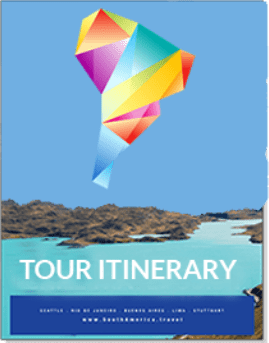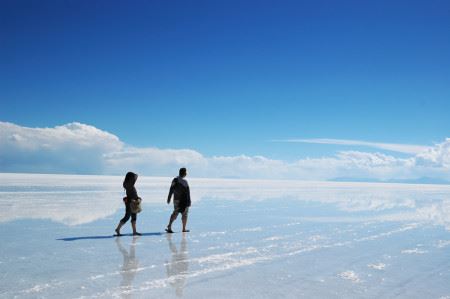Oct 7, 2013
|Last updated on November 12th, 2020 at 02:38 am
Bolivia
With the largest proportion of indigenous people in Latin America, Bolivia truly stands out among its neighbors. The landscape, too, is what Mars would resemble if llamas and quinoa populated its mountainous slopes. Traveling through Bolivia remains one of my favorite periods spent in South America. I found it far too much to do and see. Because nearly every traveler lands in the capital, we’ll start there.
La Paz
The highest capital—one of two Bolivian capitals, actually—in the world sits at nearly 12,000ft, its suburbs spilling into the valley like an urban glacier. The streets are raucous, its people miniaturized, and the fútbol games exhausting for the away team (try sprinting at that elevation!). Share lunch with the native Aymara people in the upper reaches of the city, known as El Alto. Admire the intricate trinkets at the Witches Market, such as their dried llama fetuses, used as good luck charms for a number of occasions. If you feel like your luck is already strong, you can bike down Death Road. Known as the most dangerous road in the world, bikers drop 11,000ft over 40 miles. I survived it, and recommend it for the thrill seekers! It may be said often, but there really is no place like La Paz and no end to the variety of experiences and tours you can have there.A one-hour plane ride—or a 10-hour bus ride—from La Paz brings you somewhere very different.
Uyuni
Roughly the size of Jamaica, the flattest place on Earth displays a Dali aesthetic. The salts flats of Uyuni are so flat, in fact, that orbiting satellites calibrate their altimeters by focusing on this pale, southwestern corner of Bolivia. A three-day tour of the salt flats and the surrounding area is well worth it. Along the way, you may spot flamingoes, llamas, hill stars (Andean hummingbird), viscachas (similar to a chinchilla), vicuñas (a wild variant of the llama) and maybe even a condor. Make sure to take your own perspective shots when you’re standing on the blinding salt flats! Our guides will help transfer you to your bus. Enjoy a six-hour scenic ride from Uyuni to Bolivia’s second capital city.
Sucre
Lower down the eastern side of the Andes sits Bolivia’s most beautiful city, and judicial capital of the country: Sucre. Travelers come here to marvel at the white colonial architecture and relative wealth, for the professional Spanish and Quechua language schools, and much more. Learn a few words of Quechua at the Tarabuco Sunday Market, one of the largest in the region. This is also the place to buy gifts for friends and family back home. Get an early start to your day with a few salteñas, a Bolivian treat served only in the mornings. A simple one-hour flight from Sucre takes you to Bolivia’s largest city, Santa Cruz. From there, it’s just a two and a half hour flight to Asunción.
Paraguay
Whether it’s avoiding the dry Chaco, powering the nation’s grid, or daily mixed with yerba mate, water is very important in Paraguay. Even though Paraguay shares no border with the sea, its ships bring goods to and from the Atlantic by the river. This is an obscure country in South America, and therefore a great place to visit if you’re looking for authenticity.
Asunción
Set along the Rio Paraguay, the capital of the country is full of history. Start off by visiting the oldest train station in South America, where the first steam engine chugged along in 1861. Next, head to nearby Yaguaron, which has the oldest church in Paraguay, built by the Franciscans. From there head nearby to admire the jewelry crafted in Luque. It is also there that Paraguay’s guitars and unique harps are constructed. From Asunción, the next step is the Gran Chaco and our guides will take you across one of only two bridges that connect the east half of Paraguay with the west.
The Gran Chaco
In the 1930’s Bolivia & Paraguay fought the bloody Chaco War. Nobody really won. Today, the Chaco is a dry sprawl of gauchos and Mennonites (similar to the Amish). We will take you to Filadelfia, where Mennonites work to supply the whole country with milk. Along the way, see if you can spot a nandu, South America’s ostrich. We will take you back to Asunción, in order to get to South America’s best place to view wildlife!
The Pantanal
While riding horseback through the refreshing wetlands of the Pantanal, how many animals can you spot? This region contains caiman, capybaras, crested caracaras, anacondas, marsh deer, giant anteaters, hyacinth macaws and the largest and healthiest jaguar population on earth! Remember to bring your camera, seriously.
Foz do Iguazu
Voted one of the New Seven Wonders of the World, Iguassu Falls is unleashed and stunningly dramatic. Staring down La Garganta del Diablo (the Devil’s Throat) is one of those peak experiences that actually do live up to all the hype. Very close to the falls is an example of what water can do when tamed, and it’s equally impressive. View all our Iguassu Falls Tours.
Itaipu Dam
Itaipu is either the largest or second-largest dam in the world, depending on which variable you’re concerned about. Either way, it has been voted one of the wonders of the modern world. Take a tour through the Itaipu dam that supplies 90% of Paraguay and 19% of Brazil. It is because its floodgates are never fully opened that Buenos Aires isn’t underwater! Most people will only ever explore the edges of South America. Combining a Bolivia & Paraguay tour is guaranteed to give you a memorable, varied, and rare experience.
View our Bolivia Tours and Paraguay Tours, and contact us if you would like to combine or customize any of the itineraries that you see.
Mentioned in this article













